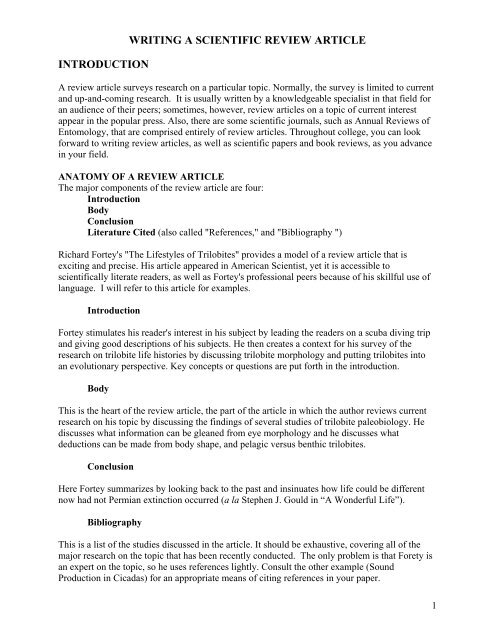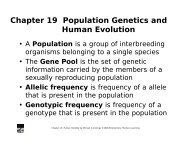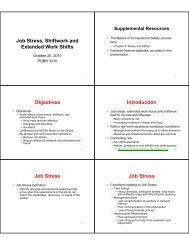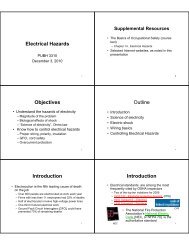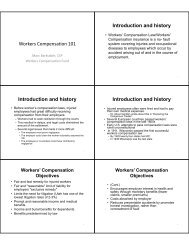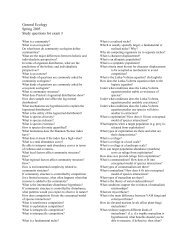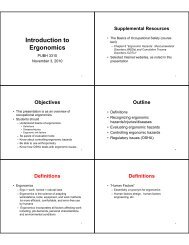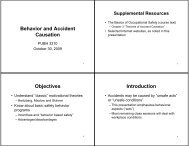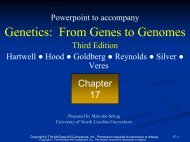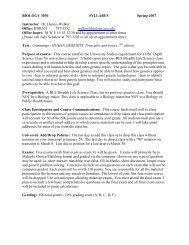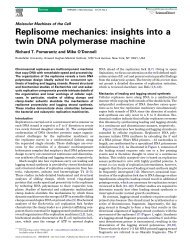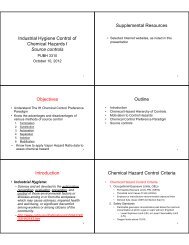Research Paper and rough draft
Research Paper and rough draft
Research Paper and rough draft
- No tags were found...
Create successful ePaper yourself
Turn your PDF publications into a flip-book with our unique Google optimized e-Paper software.
INTRODUCTIONWRITING A SCIENTIFIC REVIEW ARTICLEA review article surveys research on a particular topic. Normally, the survey is limited to current<strong>and</strong> up-<strong>and</strong>-coming research. It is usually written by a knowledgeable specialist in that field foran audience of their peers; sometimes, however, review articles on a topic of current interestappear in the popular press. Also, there are some scientific journals, such as Annual Reviews ofEntomology, that are comprised entirely of review articles. Th<strong>rough</strong>out college, you can lookforward to writing review articles, as well as scientific papers <strong>and</strong> book reviews, as you advancein your field.ANATOMY OF A REVIEW ARTICLEThe major components of the review article are four:IntroductionBodyConclusionLiterature Cited (also called "References," <strong>and</strong> "Bibliography ")Richard Fortey's "The Lifestyles of Trilobites" provides a model of a review article that isexciting <strong>and</strong> precise. His article appeared in American Scientist, yet it is accessible toscientifically literate readers, as well as Fortey's professional peers because of his skillful use oflanguage. I will refer to this article for examples.IntroductionFortey stimulates his reader's interest in his subject by leading the readers on a scuba diving trip<strong>and</strong> giving good descriptions of his subjects. He then creates a context for his survey of theresearch on trilobite life histories by discussing trilobite morphology <strong>and</strong> putting trilobites intoan evolutionary perspective. Key concepts or questions are put forth in the introduction.BodyThis is the heart of the review article, the part of the article in which the author reviews currentresearch on his topic by discussing the findings of several studies of trilobite paleobiology. Hediscusses what information can be gleaned from eye morphology <strong>and</strong> he discusses whatdeductions can be made from body shape, <strong>and</strong> pelagic versus benthic trilobites.ConclusionHere Fortey summarizes by looking back to the past <strong>and</strong> insinuates how life could be differentnow had not Permian extinction occurred (a la Stephen J. Gould in “A Wonderful Life”).BibliographyThis is a list of the studies discussed in the article. It should be exhaustive, covering all of themajor research on the topic that has been recently conducted. The only problem is that Forety isan expert on the topic, so he uses references lightly. Consult the other example (SoundProduction in Cicadas) for an appropriate means of citing references in your paper.1
VisualsA variety of figures, including photographs, cross-section diagrams, <strong>and</strong> graphs, are used tocreate a user-friendly article. These visuals add interest, clearly explain complex data, enhancereadability by breaking up text, <strong>and</strong> emphasize points about trilobite diversity that the authorstresses in the article.StyleFortey's style is highly readable because he adapts his material to the needs of readers who arenot professional paleontologists <strong>and</strong> ecologists. The most effective of these adaptations is aseries of analogies which compare <strong>and</strong> contrast trilobite behavior to extant species.Several other devices are used to help the non-specialist underst<strong>and</strong> the article, <strong>and</strong> should beused in your review article:1. Allusions are an indirect reference to some historical or cultural person, event, statement,or fact. These devices should be used sparingly.2. Kennings are compound phrases substituted for the usual name of a person or thing.(EX: “Windows to the Trilobite Soul” for eyes; these should be used sparingly.)3. Description is a verbal account of something or painting pictures verbally (You can findexamples th<strong>rough</strong>out Fortey’s article…)4. Comparison using similes <strong>and</strong> metaphors (large as dinner plates; like the size of modernshrimp…)5. Orienters are references back to previous parts of the article (Example:…closely relatedto particle feeders…)6. Transitions: For our purposes, it is how information overlaps in proceeding sentences tomaximize informational content <strong>and</strong> minimize confusion (Example: In trilobites…biconvex lenses separated by baffles. These lens are… multifaceted. The multifacetedstructure…)7. Examples are provided to add interest to the article (Many examples are given inFortey’s article.... )8. Questions are posed to elicit interest (Were they living in deep water?)9. Layman Terms are used instead of jargon words (head instead of cephalon; tail insteadof pygidium)2
HOW TO WRITE A REVIEW ARTICLE1. Choose an area of research in your field of interest. The trick here is to choose a topic that isnarrow enough to deal with in an article length piece yet broad enough so that you are able to beexhaustive, discussing all of the major work done in this area. Topics such as “Insect Behavior”or “Insect Natural History" would require a book-length review <strong>and</strong> are too broad for a reviewarticle. I have provided many topics to choose from2. To locate studies to review on your topic, you might first start with a general science articledatabase, which covers both scientific journals. These can be found th<strong>rough</strong> the USU librarywebsite.DatabasesAnimal Behavior AbstractsBIOSIS (BioScience Information Service)BIOSIS PreviewsCAB (Commonwealth Agricultural Bureau)Life Sciences CollectionZoological Record OnlineEtc.The databases will help you locate articles for your specific topic. There are 3 ways to getarticles. 1). They will be available electronically th<strong>rough</strong> the library (Caution: you have to be oncampus or need to setup your computer as a proxy of USU to download these articles); 2) thelibrary physically has the journals <strong>and</strong> you have to go copy them; <strong>and</strong> 3) the library does nothave them electronically or physically, so you will need to order the article via Interlibrary Loan(via Interlibrary Services).Searching for articles via the internet (google, etc.) may result in finding studies <strong>and</strong> informationthat may not be accurate. Anyone can put anything on the Internet; just because it is on theInternet does not mean it is true!4. After you obtain articles, you will need to decide what studies to discuss in your review. Youwill want to review at least 5 studies.5. Now that you have identified the studies you want to review, take notes on the articlesemphasizing the significant findings of each study, trends that appear, conclusions that can bedrawn or models that result from these studies. Be sure to use your own words.6. The first <strong>draft</strong>: You need to write the paper in a logical fashion. You may want to usechronological order, discussing the studies from earliest to most recent. Your material maysuggest a more effective organizational pattern. Your studies may fall into natural groups. Let thenature of your research dictate the appropriate organizational pattern for your article.When discussing studies, give the names of the principal investigator(s) the date the study wasdone, <strong>and</strong> the major findings of the study. If you are discussing the contributions of research that3
has later been proven, don't harp on the fact that these studies were wrong; make it clear that themodel is no longer viable <strong>and</strong> try to state a reason for that. Never take the tone that what thoseresearchers did wasn't science. At the end of your article you may want discuss some conclusionsthat can be drawn on the basis of the research you have just reviewed or propose one or moremodels.A First <strong>draft</strong> is due on Friday Oct 27.7. When writing the final <strong>draft</strong>, don't forget about audience:1. Make sure you're giving your audience the information that they need2. Write an interest-catching introduction3. Use attractive <strong>and</strong> effective visuals to emphasize key ideas4. Use examples <strong>and</strong> analogies; even for an audience of peers, they can be effectiveexpository devices5. Use techniques such as functional sentence perspective that can improve the flow ofcomplex information <strong>and</strong> transitions <strong>and</strong> orienters, which can make your article easier tofollow.4


